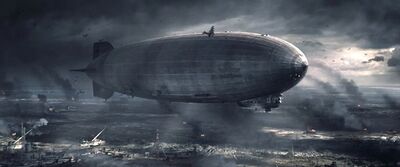Cacertian August Offensive
| Cacertian August Offensive | |||||||
|---|---|---|---|---|---|---|---|
| Part of the Desopya Campaign of the Divide War | |||||||
 HMA Sanreno over the battlefield | |||||||
| |||||||
| Belligerents | |||||||
|
|
| ||||||
| Commanders and leaders | |||||||
|
| |||||||
| Strength | |||||||
|
500,000 troops 500 tanks 12 airships 212 fighters 44 bombers 1,120 guns 12 rail-batteries |
790,000 troops 200 tanks 6 airships 322 fighters 3,265 guns 4 armored trains | ||||||
| Casualties and losses | |||||||
|
22,689 killed 64,980 wounded |
47,304 killed 144,612 wounded | ||||||
The Cacertian August Offensive, also know as Marik's Battle (Cacertian: La battaglia di Marik) or Defense of Zovahr (Syaran: Одбрана на Зовахр, Odbrana na Zovahr) was the final decisive operation of the Desopya Campaign during the Divide War. It was launched by the Cacertian Empire under the command of General Demetria Marik against the Army of Syaran Republic along the Alekso Line in Makedon. The objective of the offensive was to break through the Alekso Line and reach Zovahr, the capital of the Republic of Syara, under the belief that its capture would compel the Syarans to surrender. The Cacertians began their offensive on 6 August 1918 along a 175 kilometer front, spearheaded by 500 tanks and armored cars which breached the Alekso Line in several sectors. Supported by tanks, railway artillery batteries, airplanes and airships, the Cacertians succeeded in overrunning the Syaran tactical reserves but ran into increased Syaran resistance as their advance continued. Syaran forces, backed by over 3,000 artillery pieces, four armored trains, hundreds of aircraft, airships of their own, and 200 tanks counter-attacked across the front and succeeded in stalling the Cacertian offensive. Marik regrouped her forces on 18 August and made a final push for Zovahr, but Cacertian forces were halted by Syaran defenses near Viserajk and Rijtek. Although they were just 6 kilometers from Zovahr, the exhausted and depleted Cacertian forces were unable to press any further, and Marik called off the operation as Syaran counter-attacks began unfolding.
The offensive was the last major military action of the war. In the weeks that followed the Cacertians gradually withdrew their forces back towards the Desopya Coastal Plain and began pursuing a cessation of hostilities. The Desopya Campaign would end a month later on 22 September, and the war's end would follow in October. The victory over the Cacertian Empire provoked massive celebrations across Syara and would prove instrumental in the formation of Syaran nationalism in the years that followed the Divide War. For Cacerta, Rijtek would become informally known as the "High-Water Mark of the Empire"; the end of the war would become known as the beginning of the end of the Cacertian Empire. Historically the offensive is often seen to foreshadow the technological warfare that would come to dominate conflicts of the 20th Century. The August Offensive featured large scale usage of tanks, aircraft, and artillery, and involved the first instance of armored combat between tanks on the battlefield. The offensive was correspondingly the bloodiest of the entire war; Syaran and Cacertian casualties amounted to nearly 280,000 troops killed or wounded over the course of the fighting.
Background
By the Spring of 1918 the war was beginning to strain the Cacertian Empire. The logistical demands of supporting over half-a-million troops across on the other side of Siduri were consuming almost half of the tonnage of the Royal Navy, along with rapidly emptying the treasury. News of Syaran resistance to the Cacertian invasion was also stirring rebellious sentiments in Knichus and Arkoenn. After more than a year of war however there was little sign of an impending victory, and mounting casualties were beginning to strain public support for the war. However a withdrawal from the conflict, and by extension a concession of defeat, would risk encouraging revolts against the Empire. Following the failure of the Second Wave in April 1918 to break the deadlock, it was clear that victory was still not close at hand.
In June senior leadership of the Empire met in Vichenza to discuss the war's future. It was agreed that allowing the war to continue into 1919 was unacceptable and that a conclusion needed to be reached before the year ended. One final drive on the Syaran capital of Zovahr would be launched, with the assumption that the Republic would be forced to sue for peace with its epicenter in Cacertian hands. How to conduct the offensive provoked disagreement within Cacertian leadership. Army General Demetria Marik proposed the employment of Cacerta's first armored formations, "tanks" backed up by armored cars, to break the deadlock.
Development of tanks by Cacerta had been spearheaded by Marik since 1915, and the outbreak of the Divide War had encouraged further development. By mid-1918 though the first produced tanks were still very much in their infancy; although Marik had insisted on frequent, realistic training to get crews ready to operate them in battle, they were still untested. Mechanical problems were especially prominent; during some testing cycles mechanical breakdowns had crippled more than half the number of tanks employed. Nevertheless, this was one field where the Cacertians did enjoy advantage. Although the Syarans were aware of Cacertian tank progress, their own development of armored vehicles was trudging along slowly.
Marik proposed a combined-arms offensive to be carried out by a third wave of troops, backed up by armored companies of Padova Type 1 Assault Tanks, later expanded to include Type 2 Assault Tanks as well. The tanks would be accompanied by several Guards Rifle Divisions to assist in the breakthrough, and supported by the railway artillery batteries and airships that had arrived in the second wave. The plan was not entirely well received, with criticism focusing heavily on the untested capability of Cacertian tanks and the strength of Syaran defenses. Despite such misgivings, Empress Elianna gave her approval for Marik to carry out the offensive.